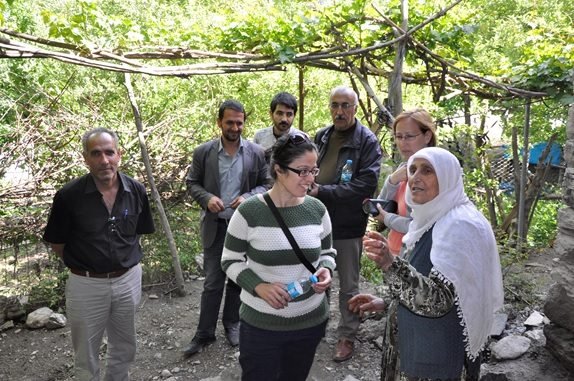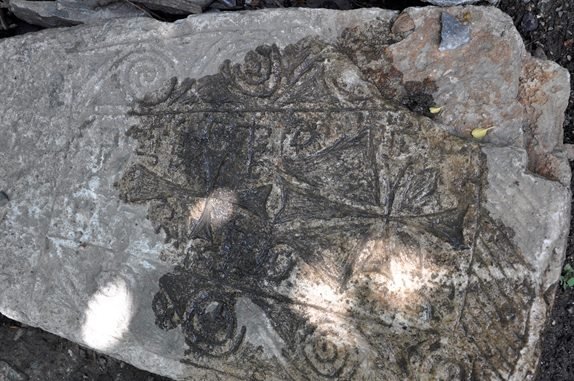Special for the Armenian Weekly
It was day one on my eighth journey to Western Armenia. My wife, Joyce, and I were sitting in a tea-house in the town of Shadakh (Çatak) with a diverse group that included a Kurdish reporter, a budding human rights attorney, and Dilan, a PhD candidate serving ably as translator. Dilan received a message that someone would like to meet with us and we were soon joined by Ali Sulmaz.

Ali Sulmaz heads the Çatak Çevre ve Tarihi Eserleri Koruma Derneği (Çatak Region and Historical Monuments Conservation Society), and on this day we were discussing the 34 Armenian churches and one monastery that remain in the Shadakh district. In what would turn out to be a common message on this journey, Ali was indicating the shame they felt in view of the current state of Armenian cultural sites, and expressed desire to restore them.
We visited what had been the largest church in Shadakh. Now, only the external walls remain, and enclosed within this sanctuary are a garden and piles of garbage. Another church is now completely walled in by a house. The church would be impossible to find without previous knowledge of its existence. We also visited Mustapha’s khan. Mustapha is the current owner of a church that had been converted into an inn in the 1800’s—hence Mustapha’s khan. I was unsure it was an Armenian church until I found a khachkar outside, unearthed recently when the road was constructed. It now stands as the last remnant of the cemetery.
The breadth of Ali’s knowledge on Armenian sites was extensive. You see, Ali’s grandmother was Armenian, and on this day, Ali, my wife and I were overwhelmed by emotion… as was our collective joy at having the opportunity to meet each other, embrace and talk. After about an hour, it was clear to me that Ali had had a special relationship with his grandmother. The result of that relationship was a miracle of Armenian identity.
I have experienced this many times in Western Armenia, particularly in areas dominated by Kurds, and each miracle encounter is special to me. It is a major reason why I make these journeys. For it is not only important to me, but it is critically important to the Alis, Asiyas, and Armens of Western Armenia.

Recently, I participated in the Armenian DNA project. In part, I did so due to my interest in the sweeping migrations of man and what my own DNA could tell of my own family’s path (maternal side haplogroup is H13a2b and paternal side haplogroup is G-PF3304, both indicating origins in Asia Minor or the Caucasus more than 15,000 years back).
But I also participated in the Family Finder test. In a familiar story, my grandmother had four sisters. Only one survived the genocide and was responsible for rescuing my grandmother from the six years she had spent as a slave. One sister died of starvation in an orphanage. The oldest, Shooshan, had been 17 years old and was most likely killed on the march to the Syrian desert, along with their mother, Tarvez, and the youngest sister, Marinos, who was under a year old.
Like others I have met on these trips, it is quite possible that Marinos was plucked from the caravan and raised as a Muslim, knowing or not knowing her Armenian identity. If enough Armenians, Kurds and Turks were to submit to DNA testing, it would pave one path to discovering family connections, and maybe one way to expose Armenian identity. I dream that one day I will find the families of our Marinos and Shooshan, or the countless others that were lost.
Pessimists will question the significance of an Armenian identity within such a dominant Kurdish and Muslim society. But I have witnessed first-hand the importance of this Armenian identity and the desire to have it blossom. We must find ways to remove the internal conflicts and external prejudices so that the Armenian identity is given that chance to flourish.
In Diyarbakir, the first buds are beginning to show: the reopening of Sourp Giragos; the hundreds that visit daily and light candles, many in Muslim attire; and the Armenian language classes attended by 40 Islamized Armenians.
House Resolution 4347 (Turkey Christian Churches Accountability Act) should be understood in this light. The bill calls on the Secretary of State to annually detail the status of Christian churches in Turkey and Northern Cyprus. Again, pessimists will wonder what purpose such a request can serve, and who would use and maintain all these churches should they be returned to their rightful owners. But this misses the point and purpose of such a resolution.

The resolution is not about Akhtamar, which was renovated by the Turkish government and turned into a museum to mock the memory of the Armenian presence on the land. If you doubt the motives of the Turkish government, you only need read the signs at Ani and Akhtamar, which contain no mention of Armenians even as the government touts these as examples of appeasement. I have absolutely no interest in investing Diasporan money renovating churches to serve as museums, a source of tourism for an unrepentant and denialist Turkish government. This is not justice.
A more appropriate, while still imperfect, example is that of Sourp Giragos Church, which is now owned by an Armenian foundation and serves the local community as both church and community center.
The resolution is both about serving the remnants retaining some Armenian identity and the return of the Armenian presence on the land where our people were born. The 30-plus churches of Shadakh, the 40-plus churches of Moks, the churches of Van, Mush, Sasun, etc.–thousands of Islamized Armenians live in communities nearby. The churches could serve both as a center for them to congregate at and a source of information on the history of the Armenians from those towns, villages, and regions.
Ali is not alone in his desire to renovate the churches in Shadakh. It is not just the Islamized Armenians that desire this, but also the local Kurdish population. Time and again, and in varied locations, this is the message we received. As we traveled the countryside, we met descendants from the Armenians taken during the Genocide and we also met local Kurds that wished for the return of Armenians. They were embarrassed by the condition of the churches, and believed it was important and right for the Armenians and their culture to once again thrive in these villages.
This is not to say that the return of some churches and tolerance towards the Armenian identity on the land is a solution to the injustice of the Armenian Genocide. It took over 1,000 years to remove the Armenian existence from our ancestral land. The just return will not happen overnight. But the expectation of a final and just resolution should not deter us from welcoming incremental steps in that direction.
Some have taken advantage of this truism to put forth harmful initiatives, such as the Turkish Armenian Reconciliation Commission and the Turkish Armenian Protocols. Similar to Akhtamar, these initiatives will not lead to justice.
Directing local resources toward the renovation of Armenian churches and promoting an environment where Islamized Armenians are made to feel equal and safe is a necessary beginning. House Resolution 4347, like Armenian Genocide resolutions before it, will serve as an important catalyst for change in Turkey, as well as religious freedom and ethnic rights.


It’s very important and very touchy subject and issue for generation to come.
Thank God we came so far. God bless all of you and your missions for justice.
An insightful commentary on a number of fronts. I flag two here: 1) The notion of ‘incremental change’ is worth opening up to greater discussion. This is a tricky subject, as the author rightly points out, but it one that can no longer be ignored. 2) Armenian identity, in this context, becomes pretty complex… certainly our orthodox notions of what classifies as ‘Armenian’ must be opened up and problematized.
Overall, this piece is quite thought-provoking. Frankly i’m surprised there haven’t been more entries in this comments section.
What does “problematized” mean?
My paternal side haplogroup is G-PF3304 as yours. i can follow my family tree till about 1750. we belong to a group of north Georgia which are actually turkomen but are in unnamed part of islam. more free and more shamanic. i think that u can not fill a DNA group in to a nation thing.. we are all from somewhere caucasus we changed got different names and we are still changing ..
i deeply love caucasus music .. the georgian even though i was never there .. i feel it inside deep somewhere .. i cant say much about the Genocide, but understand your will and power to know more about what happend. i had a grandaunt which was a child at that years and she was telling us stories about it. what i understood from her stories was that someday some man came and told them that his neighbor is actually an enemy. so they started to kill eachother.. sad but it happend. i know also people who learned after years that they were actually something different..
take care best wishes